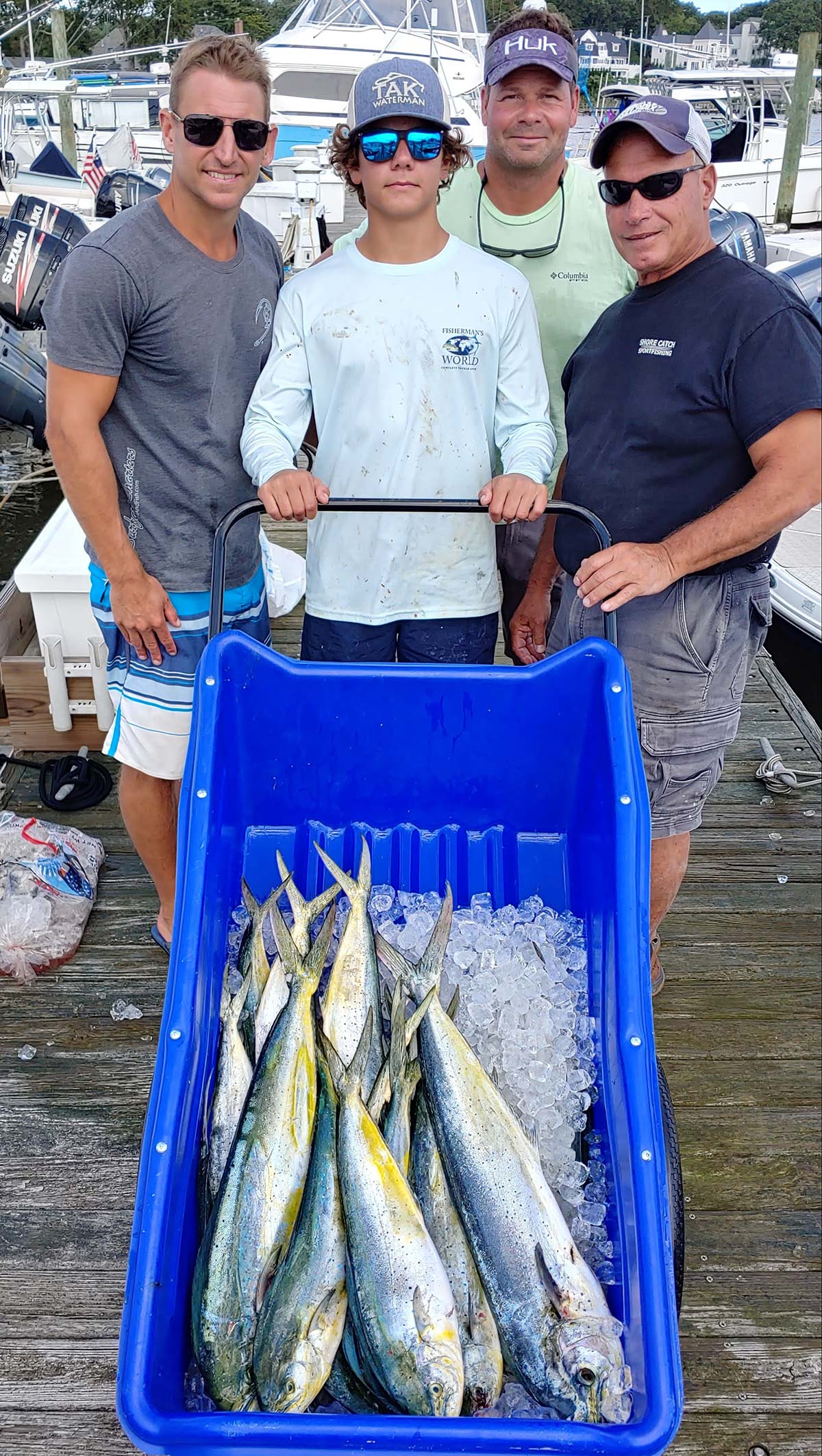
So strong strong that they named mahi mahi twice!
Each summer one of the most spectacular looking fish in the ocean, mahi mahi, invade our Northeast and Mid-Atlantic waters, making for some exhilarating light tackle action. These migratory pelagic visitors can be found from 10 to 50 miles out around any lobster pot, buoy, weed line, sargassum, partially submerged pilings, floating timber, or anything else that serves as a source of structure where a food chain can develop.
Mahi are acrobatic feeding machines and one of the fastest growing in the ocean. Typical size mahi that we will catch will range from small chickens up to about 15 pounds. But there is always a real good chance that a bull of more than 15 pounds can be caught. The bulls are particularly striking in color draped in a mix of gold, metallic blue and green, with a white and yellow belly. They also have a prominent forehead that protrudes well above the body that distinguishes them from a female.
When hooked both males and females literally light up in their full array of iridescent colors. For this reason, they make for a great addition to that fishing photo scrapbook and even better they make for a great tasting meal too. Their meat is mild-tasting with a sweet-flavor and has a firm texture that can be prepared in a variety of ways.
Catching mahi on light spinning tackle or on the fly rod can save the day when you come up empty on a tuna trip. Mahi won’t double you over the gunnels of your boat like a runaway tuna but this fish will still give you a challenging and adrenaline pumping fight. Their name mahi mahi is indicative of this as it describes their fish fighting nature as in Hawaiian it means “strong strong.”
Live baits like peanut bunker, a variety of different artificials, and flashing flies will all take mahi. If you can net peanuts at your marina before you leave this will be ideal as tossing these baits at any target will put mahi into a feeding frenzy. Once the mahi are fired up your artificials or flies will be taken much more readily. Without bait in the water the mahi will be more discriminate towards the artificials as they have time to eyeball them up and recognize them as something that doesn’t look natural. Many times, you will see the mahi follow your offering right back to the boat and then disappear. If you don’t have bait to toss out then the best bet is to be the first to arrive at a target before it gets worked over; this will improve your chances greatly as mahi will usually strike out at the first thing that comes their way.
Tossing peanuts in the water and baiting a hook with the same will be the easiest and quickest way to load up your cooler. When you throw these around a lobster pot for example and see mahi come up and inhale them, you’re generally in in business as many more mahi will usually be below. To fish a live peanut bunker, use a size 1 Gamakatsu Nautilus Light circle hook tied to 6 feet of 20-pound fluorocarbon leader tied to your main line with a small barrel swivel. A small egg sinker can also be added above the swivel to get the peanut deeper especially when fishing around a lobster pot. Here, mahi can be hanging as deep as 50 feet sometimes.
If you don’t have live peanuts don’t fret as all is not lost as you can use any of the sardines that you might have left over from your tuna trip to get the mahi going. I like to take sardines and cut them into one-inch chunks and place these on a small circle hook while tossing a bunch of chunks around a buoy or pot.
Mahi will also readily take small soft baits from the likes of Tsunami, Hogy, or RonZ. One of my favorite setups is a 4-inch pink skinny Hogy rigged on a half-ounce pink Spro Squidtail jig. Prismatic swimming plugs, small metals, and poppers can also be cast around a target. I also love having my clients catch mahi on the fly, with brightly colored and flashy flies (bright orange, yellow, florescent green, pink, white, or a mix blend) working best to draw strikes. I like to toss baits at the target to get the mahi going to help the fly angler connect. Or I will hook a mahi on bait and then keep it in the water next to the boat to bring others within fly casting range.



